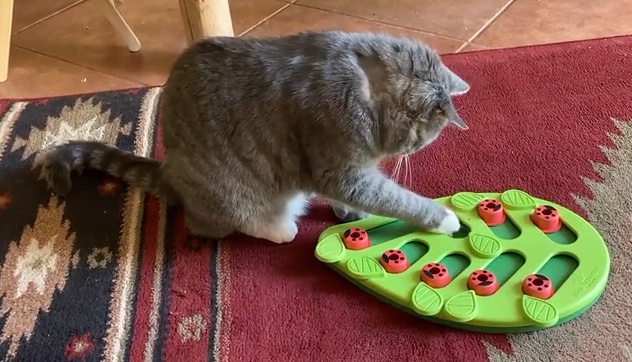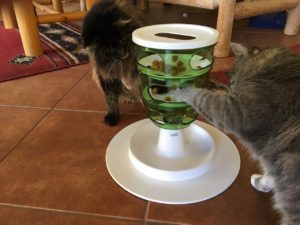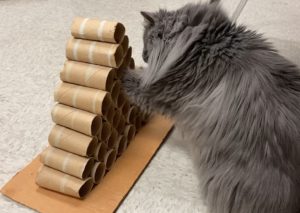 Why slide a block aside to uncover food when there is food freely available in a bowl nearby? Psychologists call the behavior “contrafreeloading” – it refers to animals (and people) preferring to work for food when there is freely available food.
Why slide a block aside to uncover food when there is food freely available in a bowl nearby? Psychologists call the behavior “contrafreeloading” – it refers to animals (and people) preferring to work for food when there is freely available food.
This behavior sounds counter-intuitive – after all, you would expect an animal to choose the option that requires the least effort. But psychologists and behaviorists propose that contrafreeloading is a manifestation of the SEEKING system – one of the seven basic emotional systems proposed by Jaak Panksepp, the father of “affective neuroscience”. Affective neuroscience studies how the brain produces emotional responses.
The SEEKING system is thought to be the strongest of the primary emotional systems. It’s what gets animals out looking for food, looking for a mate, looking for other resources.
When the SEEKING system is activated
- the brain releases dopamine, a neurotransmitter that makes you feel pleasure.
- It is the rewarding feeling you get when you are looking for something and find it.
- Once you’ve found the object of your desire, the brain shuts off the dopamine and other emotions are activated.
So the action of SEEKING can be more enjoyable than finding what you’re looking for. Think about those travel advertisements that tell you that “getting there is half the fun”!
Dogs, mice, rats, birds, monkeys and even humans have been found to engage in “contrafreeloading”.
cats eating from a food puzzle: contrafreeloading?
A recent study by Mikel Delgado and colleagues enrolled 20 domestic cats to observe this behavior. They investigated the behavior of cats eating from a food puzzle versus eating food from a tray. Cats eating from a food puzzle have to manipulate the puzzle to get the food out.
The cats were first trained to the puzzle by having increasing amounts of their food in the puzzle and decreasing freely available food on a tray.
- At first, only 25% of their food was in the puzzle.
- Once they started to eat some food from the puzzle, the amount in the puzzle was increased to 50%, then to 75%.
- Three cats refused to eat any food from the puzzle and were dismissed from the study.
- Cats were exposed to the equipment for 4-12 days before testing.
Cats underwent 2-4 trials a day, no less than 2 hours apart. The puzzle and the food tray were placed next to each other, and were the same distance from the cat. The cat’s daily food ration was divided equally between trials. In each trial, the food was divided up equally between the puzzle and the food bowl.
Cats are freeloaders!
Half of the cats ate less than 10% of their food from the puzzle. All of the cats ate most of their food from the tray – no cats were strong “contrafreeloaders”. Eight cats were definitely “freeloaders” – the rest seemed willing to do some contrafreeloading. Although a number of cats approached and sniffed the puzzle first, all the cats ate from the tray first.
Cats seem to be one of the few species that does not seem to be inclined to work for their food in a captive environment. But cats have been known to STOP EATING to hunt prey – that certainly involves working for food!
why are cats freeloaders?
Cats eating from a food puzzle are engaging in “foraging” behavior.
Cats are solitary predators
- They must conserve their energy for the energy burst needed when hunting
- They are not above scavenging a free meal
- Maybe it makes sense to a cat to eat some of the “free food” first before putting energy into foraging?
Is hunting more “fun”?
- Is the SEEKING system stronger for cats when they hunt compared to when they forage?
- Do their brains release more dopamine when they are stalking, pouncing and chasing?
- Do their brains release less dopamine when they are foraging?
cats eating from a food puzzle
Does this mean you should not bother offering your cat food puzzles for enrichment? No – food puzzles help reduce boredom and engage cats mentally. Indoor cats in particular may benefit from using food puzzles.
training your cat to use a food puzzle
- Start by offering 25% of the meal in the food puzzle and 75% in a bowl or tray.
- When your cat is eating some of the food in the puzzle, increase the amount of food in the puzzle to 50% and decrease the amount in the bowl to 50%.
- Increase the amount of food in the puzzle to 75%; decrease the amount in the bowl to 25%
- When your cat is eating most of his meal in the puzzle, offer him the puzzle only.
A demonstration can help your cat learn. Cats are able to mimic the actions of humans and they are able to adapt human actions to their own bodies.
selecting a food puzzle

There are many food puzzles you can make or purchase. Start your cat with a “beginner” puzzle and see what he likes to do. My ex-feral cat, Gus, easily mastered the Catit “Food Tree” but it was almost a year or so before he was willing to try a flat panel puzzle where he had to move pieces to uncover the food.

You may want to make some puzzles first to find out your cat’s preferences before purchasing one. Visit foodpuzzlesforcats.com!



1 thought on “Cats eating from a food puzzle: contrafreeloading?”